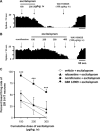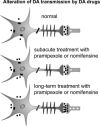Relevance of norepinephrine-dopamine interactions in the treatment of major depressive disorder
- PMID: 20406250
- PMCID: PMC2904493
- DOI: 10.1111/j.1755-5949.2010.00146.x
Relevance of norepinephrine-dopamine interactions in the treatment of major depressive disorder
Abstract
Central dopaminergic and noradrenergic systems play essential roles in controlling several forebrain functions. Consequently, perturbations of these neurotransmissions may contribute to the pathophysiology of neuropsychiatric disorders. For many years, there was a focus on the serotonin (5-HT) system because of the efficacy of selective serotonin reuptake inhibitors (SSRIs), the most prescribed antidepressants in the treatment of major depressive disorder (MDD). Given the interconnectivity within the monoaminergic network, any action on one system may reverberate in the other systems. Analysis of this network and its dysfunctions suggests that drugs with selective or multiple modes of action on dopamine (DA) and norepinephrine (NE) may have robust therapeutic effects. This review focuses on NE-DA interactions as demonstrated in electrophysiological and neurochemical studies, as well as on the mechanisms of action of agents with either selective or dual actions on DA and NE. Understanding the mode of action of drugs targeting these catecholaminergic neurotransmitters can improve their utilization in monotherapy and in combination with other compounds particularly the SSRIs. The elucidation of such relationships can help design new treatment strategies for MDD, especially treatment-resistant depression.
Conflict of interest statement
P. Blier has received grants, honoraria for serving on advisory boards and/or making presentation for Astra‐Zeneca, Biovail, Eli Lilly, Janssen, Lundbeck, Organon, Pharmacia and Wyeth.
Figures







Similar articles
-
Monoamine neurocircuitry in depression and strategies for new treatments.Prog Neuropsychopharmacol Biol Psychiatry. 2013 Aug 1;45:54-63. doi: 10.1016/j.pnpbp.2013.04.009. Epub 2013 Apr 19. Prog Neuropsychopharmacol Biol Psychiatry. 2013. PMID: 23602950 Review.
-
Neurobiology of depression and mechanism of action of depression treatments.J Clin Psychiatry. 2016 Mar;77(3):e319. doi: 10.4088/JCP.13097tx3c. J Clin Psychiatry. 2016. PMID: 27046319
-
Serotonin and beyond: therapeutics for major depression.Philos Trans R Soc Lond B Biol Sci. 2013 Feb 25;368(1615):20120536. doi: 10.1098/rstb.2012.0536. Print 2013. Philos Trans R Soc Lond B Biol Sci. 2013. PMID: 23440470 Free PMC article. Review.
-
[Consequences of the monoaminergic systems cross-talk in the antidepressant activity].Encephale. 2018 Jun;44(3):264-273. doi: 10.1016/j.encep.2018.05.001. Epub 2018 May 22. Encephale. 2018. PMID: 29801770 Review. French.
-
Catecholaminergic strategies for the treatment of major depression.Curr Drug Targets. 2006 Feb;7(2):149-58. doi: 10.2174/138945006775515464. Curr Drug Targets. 2006. PMID: 16475956 Review.
Cited by
-
Interaction Between Brain Histamine and Serotonin, Norepinephrine, and Dopamine Systems: In Vivo Microdialysis and Electrophysiology Study.J Mol Neurosci. 2015 Jun;56(2):320-8. doi: 10.1007/s12031-015-0536-3. Epub 2015 Mar 29. J Mol Neurosci. 2015. PMID: 25820671
-
The role of Neurochemicals, Stress Hormones and Immune System in the Positive Feedback Loops between Diabetes, Obesity and Depression.Front Endocrinol (Lausanne). 2023 Aug 17;14:1224612. doi: 10.3389/fendo.2023.1224612. eCollection 2023. Front Endocrinol (Lausanne). 2023. PMID: 37664841 Free PMC article. Review.
-
Depression in sleep disturbance: A review on a bidirectional relationship, mechanisms and treatment.J Cell Mol Med. 2019 Apr;23(4):2324-2332. doi: 10.1111/jcmm.14170. Epub 2019 Feb 7. J Cell Mol Med. 2019. PMID: 30734486 Free PMC article. Review.
-
Integrated dopaminergic neuronal model with reduced intracellular processes and inhibitory autoreceptors.IET Syst Biol. 2015 Dec;9(6):245-58. doi: 10.1049/iet-syb.2015.0018. IET Syst Biol. 2015. PMID: 26577159 Free PMC article.
-
Revisiting the Serotonin Hypothesis: Implications for Major Depressive Disorders.Mol Neurobiol. 2016 Jul;53(5):2778-2786. doi: 10.1007/s12035-015-9152-z. Epub 2015 Apr 1. Mol Neurobiol. 2016. PMID: 25823514 Review.
References
-
- Blier P, De Montigny C. Current advances and trends in the treatment of depression. Trends Pharmacol Sci 1994;15:220–226. - PubMed
-
- Maes M, Meltzer HY. The serotonin hypothesis of major depression In: Bloom FE, Kupfer DJ, editors. Psychopharmacology: The fourth generation of progress. New York : Raven Press, 1995;933–944.
-
- Heninger GR, Charney DS. Mechanisms of action of antidepressant treatments: Implications for the ethiology and treatment of depression disorders In: Meltzer HY, editor. Psychopharmacology: The third generation of progress. New York : Raven Press, 1987;535–544.
-
- Delgado PL. Monoamine depletion studies: Implications for antidepressant discontinuation syndrome. J Clin Psychiatry 2006;67(Suppl 4):22–26. - PubMed
-
- Dunlop BW, Nemeroff CB. The role of dopamine in the pathophysiology of depression. Arch Gen Psych 2007;64:327–337. - PubMed
Publication types
MeSH terms
Substances
LinkOut - more resources
Full Text Sources
Other Literature Sources
Medical

